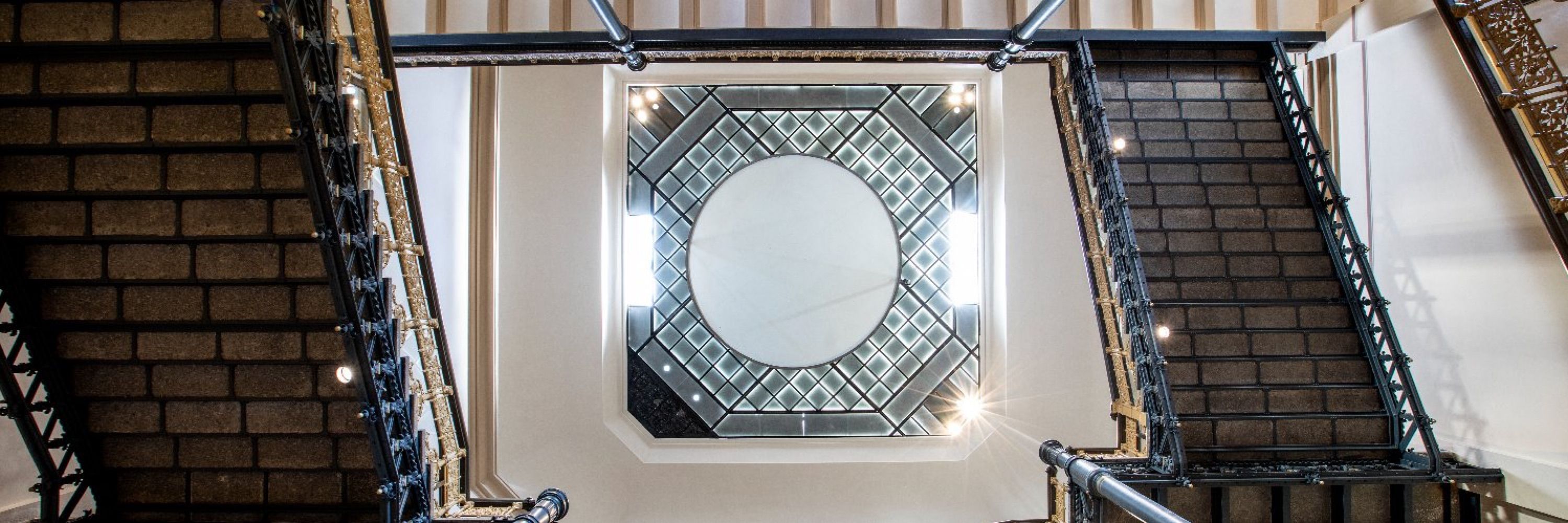

👉 Heute am WZB in der Reihe "Wissenschaft, natürlich!": Präsidentin Nicola Fuchs-Schündeln & Johannes Vogel, Generaldirektor @mfnberlin.bsky.social, im Gespräch.
Kommt gerne vorbei:
www.wzb.eu/de/veranstal...

👉 Heute am WZB in der Reihe "Wissenschaft, natürlich!": Präsidentin Nicola Fuchs-Schündeln & Johannes Vogel, Generaldirektor @mfnberlin.bsky.social, im Gespräch.
Kommt gerne vorbei:
www.wzb.eu/de/veranstal...
Heritage & Justice is a digital colloquium exploring how legal and ethical frameworks shape natural history collections and their colonial legacies. 🌍
📅 Next session: 12 Nov, 13:00–14:00 CET
💻 Open to all via Zoom
🔗 bit.ly/3Ly2k1G
📸 P. Castagnola

Heritage & Justice is a digital colloquium exploring how legal and ethical frameworks shape natural history collections and their colonial legacies. 🌍
📅 Next session: 12 Nov, 13:00–14:00 CET
💻 Open to all via Zoom
🔗 bit.ly/3Ly2k1G
📸 P. Castagnola
www.museumfuernaturkunde.berlin/en/museum/me...

www.museumfuernaturkunde.berlin/en/museum/me...
55 years missing: An international team led by the museum rediscovered the Turkestan long-eared bat in the Karakum Desert. Endemic species like 𝘗𝘭𝘦𝘤𝘰𝘵𝘶𝘴 𝘵𝘶𝘳𝘬𝘮𝘦𝘯𝘪𝘤𝘶𝘴 reveal how life adapts – and why protecting unique habitats matters. 🌏
📹 Christian Dietz
#biodiversity #bats
55 years missing: An international team led by the museum rediscovered the Turkestan long-eared bat in the Karakum Desert. Endemic species like 𝘗𝘭𝘦𝘤𝘰𝘵𝘶𝘴 𝘵𝘶𝘳𝘬𝘮𝘦𝘯𝘪𝘤𝘶𝘴 reveal how life adapts – and why protecting unique habitats matters. 🌏
📹 Christian Dietz
#biodiversity #bats
Researchers from the Museum für Naturkunde Berlin documented brown rats catching #bats in mid-air at Segeberger Kalkberg, Northern Germany. A rare look at invasive species impacting urban wildlife. 🌍 @berlinbatlab.bsky.social
🔗 doi.org/10.1016/j.ge...
Researchers from the Museum für Naturkunde Berlin documented brown rats catching #bats in mid-air at Segeberger Kalkberg, Northern Germany. A rare look at invasive species impacting urban wildlife. 🌍 @berlinbatlab.bsky.social
🔗 doi.org/10.1016/j.ge...
👀 Find out how FORSAID partners from @pensoft.net
and @mfnberlin.bsky.social left their mark at the event:
🔗 forsaid.eu/news/living-...
#Forests #Pests #PlantHealth



👀 Find out how FORSAID partners from @pensoft.net
and @mfnberlin.bsky.social left their mark at the event:
🔗 forsaid.eu/news/living-...
#Forests #Pests #PlantHealth
This weekend, the festival kicks off with the CAMPUS at the Museum für Naturkunde Berlin – free entry for everyone! Discover science up close with talks, workshops & hands-on formats. 🧠
👉 Full programme: berlinscienceweek.com
📸 Falling Walls

This weekend, the festival kicks off with the CAMPUS at the Museum für Naturkunde Berlin – free entry for everyone! Discover science up close with talks, workshops & hands-on formats. 🧠
👉 Full programme: berlinscienceweek.com
📸 Falling Walls
🐞 One of the event's keynote speakers, he delivered a presentation on technological innovation in the context of biodiversity discovery.


🐞 One of the event's keynote speakers, he delivered a presentation on technological innovation in the context of biodiversity discovery.
Explore how culture and tech can develop business models together – join our workshop at #BerlinScienceWeek CAMPUS next week at mfnberlin! 🧠
📅 Sat. / 01.11.2025 / 13:00–15:00
🔗 Register: bit.ly/4hpYDa9
📸 Credits: Györgyi Kovács

Explore how culture and tech can develop business models together – join our workshop at #BerlinScienceWeek CAMPUS next week at mfnberlin! 🧠
📅 Sat. / 01.11.2025 / 13:00–15:00
🔗 Register: bit.ly/4hpYDa9
📸 Credits: Györgyi Kovács
Join our #art and #science workshop "Soil, wildfires and biological remediation” with Margherita Pevere, in collaboration with #mfnberlin researchers Katharina and Parm von Oheimb! 🐌
🗓️ Sat, 25 Oct, 14:00 to 18:00
🔗 bit.ly/soil-wildfires

Join our #art and #science workshop "Soil, wildfires and biological remediation” with Margherita Pevere, in collaboration with #mfnberlin researchers Katharina and Parm von Oheimb! 🐌
🗓️ Sat, 25 Oct, 14:00 to 18:00
🔗 bit.ly/soil-wildfires



Researchers from #Brazil, Singapore and Germany collected fungus gnats in #Singapore and found 120 species – 115 new to #science! 🌏
Among them: 𝘈𝘭𝘭𝘢𝘤𝘵𝘰𝘯𝘦𝘶𝘳𝘢 𝘭𝘪𝘮𝘣𝘰𝘴𝘦𝘯𝘨𝘪 and 𝘈𝘭𝘭𝘢𝘤𝘵𝘰𝘯𝘦𝘶𝘳𝘢 𝘵𝘶𝘮𝘢𝘴𝘪𝘬. 🧵 (1/2)
#sciencenews


Researchers from #Brazil, Singapore and Germany collected fungus gnats in #Singapore and found 120 species – 115 new to #science! 🌏
Among them: 𝘈𝘭𝘭𝘢𝘤𝘵𝘰𝘯𝘦𝘶𝘳𝘢 𝘭𝘪𝘮𝘣𝘰𝘴𝘦𝘯𝘨𝘪 and 𝘈𝘭𝘭𝘢𝘤𝘵𝘰𝘯𝘦𝘶𝘳𝘢 𝘵𝘶𝘮𝘢𝘴𝘪𝘬. 🧵 (1/2)
#sciencenews
#Fossils from Thuringia reveal the world’s oldest insect plague – 295 million years old. Understanding global change thanks to natural history collections! 🌍
🔗 www.nature.com/articles/s41...
#science #sciencenews


#Fossils from Thuringia reveal the world’s oldest insect plague – 295 million years old. Understanding global change thanks to natural history collections! 🌍
🔗 www.nature.com/articles/s41...
#science #sciencenews









📍 Infos + Anmeldung unter www.ethikrat.org
#Ethikrat #WissenundMacht
📍 Infos + Anmeldung unter www.ethikrat.org
#Ethikrat #WissenundMacht
wissenschaft-im-dialog.de/blog/campus-...
#KI #Wisskomm
wissenschaft-im-dialog.de/blog/campus-...
#KI #Wisskomm
Join our "Ideas for a liveable Berlin" event to explore how shared knowledge can shape our city’s future. 🤝
🗓️ Mon, 13 Oct | 18:00 | @leibniz-gemeinschaft.de
🔗 eventbrite.com/e/1719108452659
📸 Pablo Castagnola

Join our "Ideas for a liveable Berlin" event to explore how shared knowledge can shape our city’s future. 🤝
🗓️ Mon, 13 Oct | 18:00 | @leibniz-gemeinschaft.de
🔗 eventbrite.com/e/1719108452659
📸 Pablo Castagnola
Schau mal ins Programm!
🌐 www.achtung-artenvielfalt.de
@sgn.one
@mfnberlin.bsky.social



Schau mal ins Programm!
🌐 www.achtung-artenvielfalt.de
@sgn.one
@mfnberlin.bsky.social


@mfnberlin.bsky.social

@mfnberlin.bsky.social

